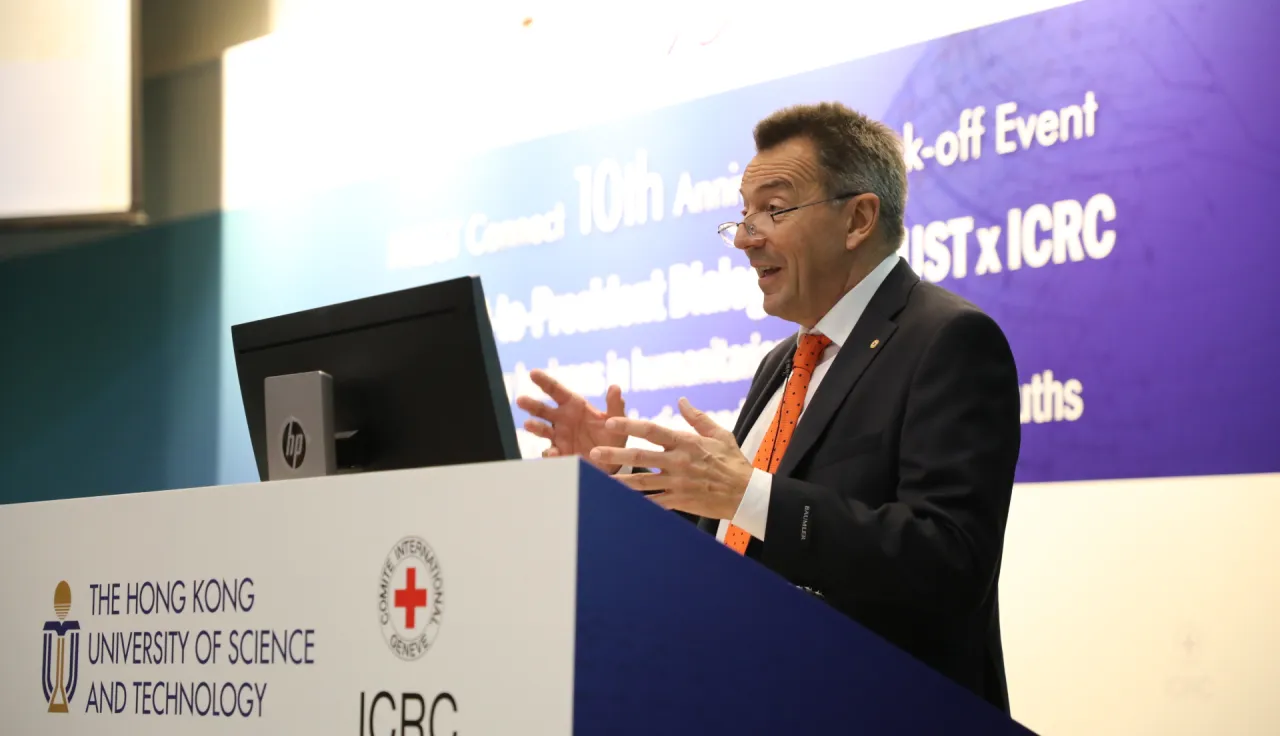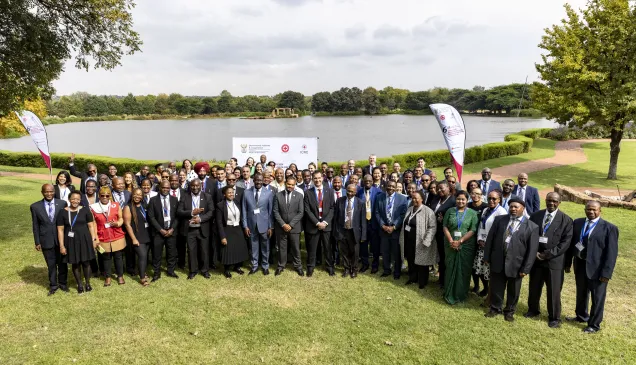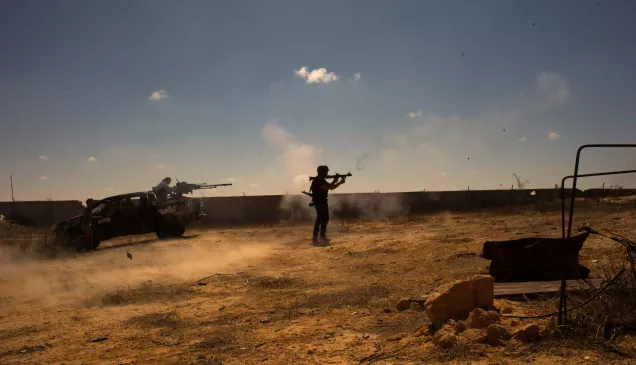New horizons in humanitarian diplomacy: Power of new technologies and Asian youth

Speech of ICRC President Peter Maurer at Hong Kong University of Science and Technology, November 22, 2018.
Predicting the dynamics of the wars of tomorrow, while keeping one eye on the conflicts of today is no easy task.
We have an ongoing debate at the ICRC : some argue there have always been wars and violence causing great human suffering; others say we are facing increasing levels of need and new dynamics of warfare.
Perhaps there is truth in both views: while it is true that the number of international armed conflicts has decreased, non-international conflicts have more than doubled over the last 18 years.
From what I observe, it is clear that we are seeing particular trends emerging. These dynamics are significant on their own, but they increasingly overlap, creating great complexity and bringing our world into deep levels of fragility.
The result we are seeing is more people affected, for a longer time, through deeper needs, from food, water and shelter, to health care services, to economic opportunities. Our world is characterised by:
- Rapid, but uneven socio-economic progress, with economic inequalities fuelling social injustice as well as political, ethnic, and religious tensions;
- Public governance failing at multiple levels and creating a crisis of trust in social contracts;
- New actors emerging on the political landscape, contesting traditional powers;
- The physical and virtual worlds merging to create augmented realities;
- Climate change, population growth and urbanization accelerating the degradation of our planet and its natural resources;
- The technological achievements that have empowered people are also creating unprecedented infringements on their freedoms and fundamental rights;
- And a vast scale of need – today two billion people are affected by fragility, conflict or violence; and the annual economic impact is $14 trillion - or 14% of global GDP.
The ICRC is working to understand the complex impacts of these trends in the 80 countries around the world where we work. Our mandate remains as it has been for more than 150 years: to provide humanitarian relief and protection based on the principles of neutrality, independence and impartiality. But the world we live in has certainly transformed and we are adapting with it.
I'd like to highlight two changing areas relating to our discussion today – the impact of emerging technologies on warfare, the changing nature of the ICRC's humanitarian workforce.
The Fourth Industrial Revolution and digital transformation, are changing our world in ways never previously imagined. You know yourselves how digital connectivity is having huge changes on the way we live, work, socialise. It is also changing how wars are fought and the ways in which humanitarians need to respond.
Digital connectivity is allowing us to design more impactful humanitarian solutions, based on people's self-identified needs, and for more efficient coordination between services.
- With business and scientific communities, we're working to use the potential of big data to analyse contexts and needs and to test new platforms for cooperation.
- Conflict-affected communities are increasingly connected, opening up tremendous opportunities for two-way information exchange.
- It will become easier, for example, to collect and analyze data about where refugees are going – and to share critical information with them about their options in fast-changing situations.
- We are also using technological advances to improve patient outcomes in physical rehabilitation.
- Collaborating with an academic partner we are developing a new prosthetic foot, which not only has greater functionality but is more cost efficient to produce.
- High-tech facial recognition technology is being tested to help ICRC to reconnect more families separated by war or displacement. The technology is allowing us to scan photographs provided by enquirers to similar facial features to images in our database which we can cross check with enquirers.
While the contact with families will and must always be one of compassionate engagement by our trained staff and volunteers, we hope that the automating part of the process will increase the numbers of people we can reunite.
The flipside of advancing technology is the potential for harm and for it to be used to wage war. The ICRC is increasingly concerned about the potential human cost of cyber operations. Cyber military capabilities, like all forms of warfare and all kinds of weapons, must be capable of being used without violating International Humanitarian Law. If these general rules are adhered to strictly and in good faith, they can greatly contribute to limiting the human cost of cyber warfare.
At the same time, we must also consider stronger, more tailor-made rules to protect civilians from conflict's future frontlines. The interconnectedness of military and civilian networks poses a significant practical and legal challenge in terms of protecting civilians from the dangers of cyber warfare.
The ICRC is urging governments and companies to deal with the humanitarian impact of conflict in the virtual world, and to address critical questions: what's a security incident vs. an act of war? How does proportionality apply? How can virtual attacks distinguish between civilian objects and military objectives? What are legitimate processes to assess attributions of attacks?
Another concern is the application of technology to weapons. Autonomous weapons, AI and machine learning are having a transformative effect by advancing how we analyze and act upon data from the world around us.
It makes sense that this technology be considered for national security and defense purposes, which is why it's not a surprise that we are seeing many countries invest heavily in AI and in military robotic systems with greater autonomy. But when it comes to armed conflict, we must not forget that wars have limits.
Governments defining the limits for autonomous weapon systems, need to ensure compliance with international humanitarian law and be firmly rooted in the principles of humanity and the dictates of public conscience.
Turning to the second issue of tonight's discussion – the changing face of humanitarian responders and supporters.
Once the ICRC was predominantly staffed by Swiss citizens, now, around 80 per cent of the 16,000 ICRC staff are recruited from the countries they work in.
Additionally we are part of the larger Red Cross Red Crescent Movement, with more than 17 million volunteers in 191 countries. This is an incredibly powerful movement of dedicated and courageous humanitarians. Here, the Hong Kong Red Cross and the ICRC are working together to raise awareness locally about humanitarian needs. While we have a strong international footprint, there is certainly more we can do, especially to tap into the growing influence of Asia.
The ICRC is looking forward to recruit more qualified young professionals from Hong Kong and from Asia in general, who are enthusiastic about engage in international humanitarian careers.
With this is mind we are pleased to be collaborating with HKUST on a traineeship at our headquarters in Geneva. The trainee, Ms. Rachel Huang is currently working in our government donor team and contributing her insights from this region.
We are also mindful of the strength of the HKUST as the top young university in the world and its strong alumni network especially in the EMBA program. I have no doubts there are further opportunities to explore.
We also welcome your ideas about how to encourage greater involvement of young people in Asia with humanitarian issues.
The challenges are vast: today more than 120 million people are depending on some sort of humanitarian assistance. It will need all of us, bringing skills and new ideas to the table to help to overcome this collective challenge.



